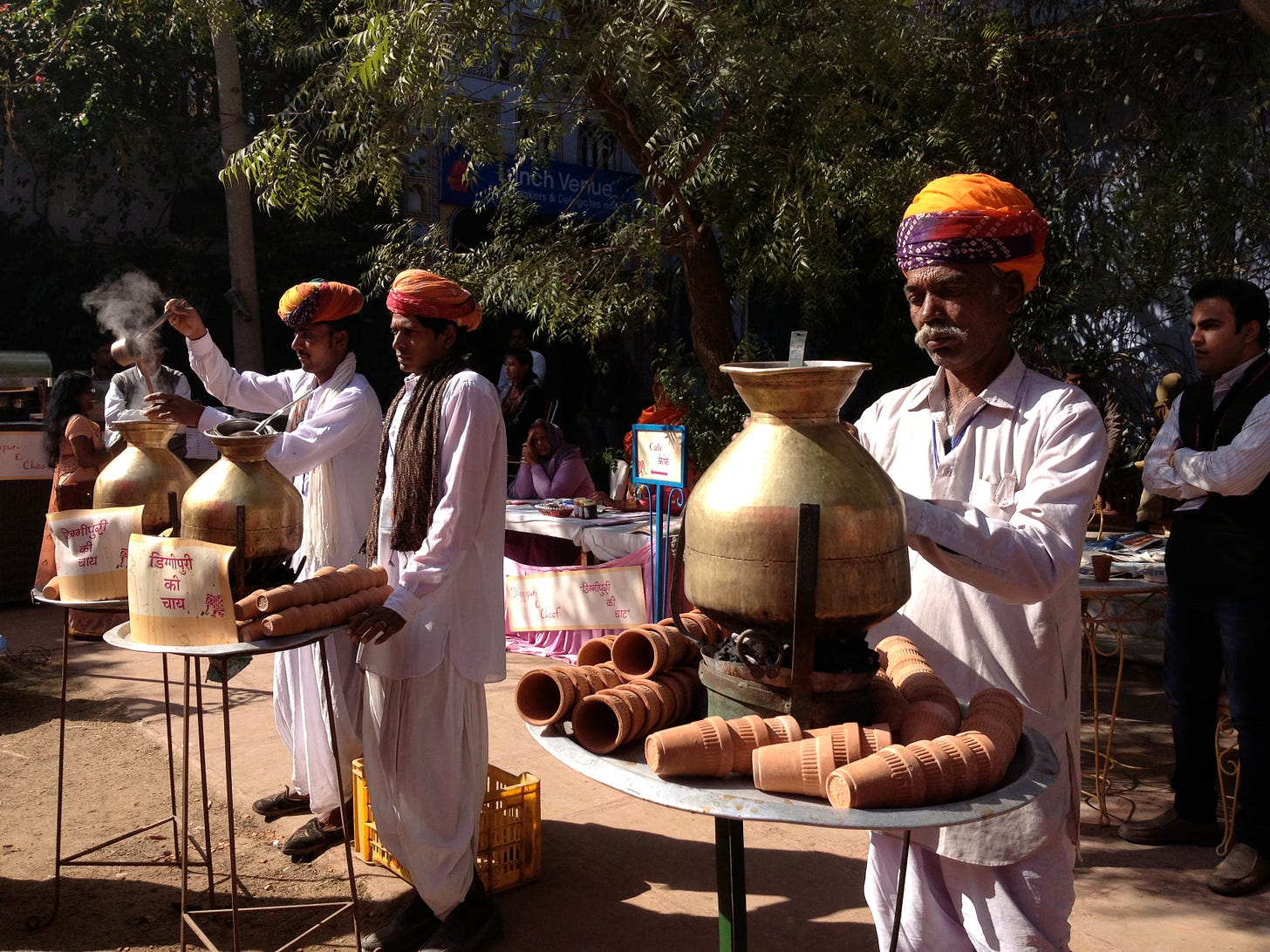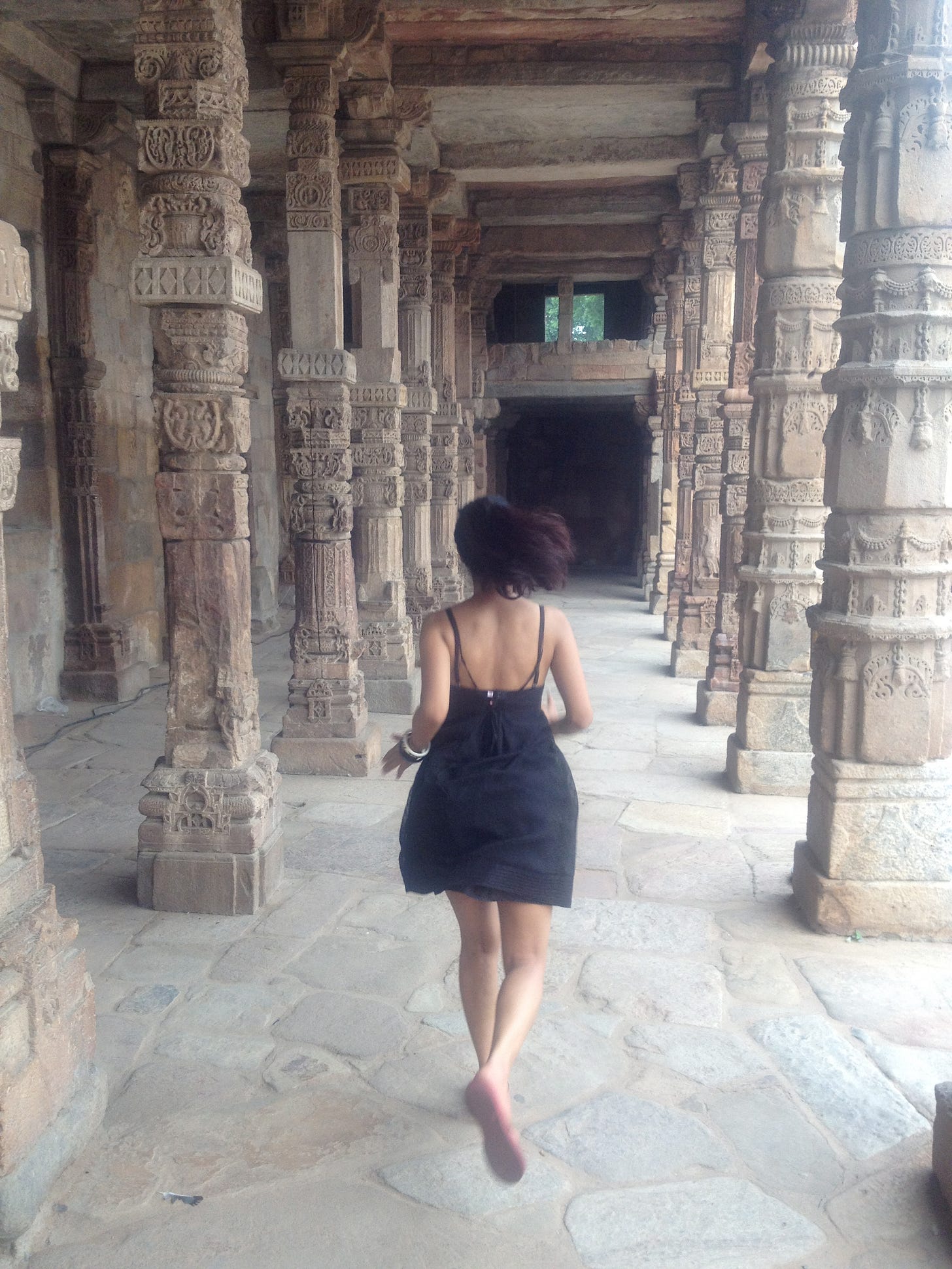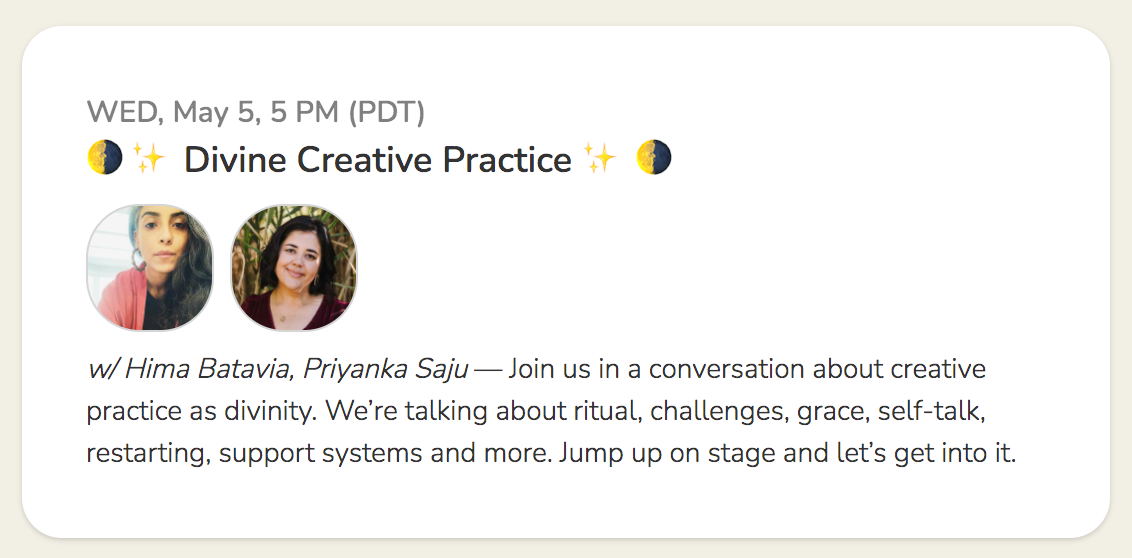Hi, I’m Hima Batavia - a writer, cultural producer, artist, and community organizer based in T’karonto and the great infinite. This newsletter is a space to write liberated futures into being. You can learn more about me, my social location, and this newsletter here.
Dear India
My relationship with India can be summed up as this: everytime the plane lands, I immediately well into jubilant tears. I don’t know if that means it feels like home, or what belonging is suppose to feel like. If I am delighted by the influx of sensory chaos present in daily life or the novelty of it all, but there is a melting into the milieu I experience in India like no where else I have been to in the world. I didn’t grow up going to India, and I don’t have a large immediate family there (because my parents were born in Africa), but I lived in Delhi for a few years, and it completely changed my life; I am infinitely better and more human having got to know and fall in love with India.
And still, India will break you and your heart. Because you will have to confront that most people in the country and the world live on the edge of survival, in material scarcity and in the knowing that the constructs of class and caste mean very few people have value for your life, even though you are as human and as deserving as the rest. You will see this everyday, from the moment your eyes shutter open and hear the calls of boney men selling coconuts, until they close, the horns or rikshas and cars never ceasing. You will intersect with class disparity in a way that feels fixed and immutable, despite the colonial sham of it all, and either sit in the unresolvable conflict or find a story to still your weary heart. It is impossible to understand what and how long it takes for a country and citizenry to heal and repair after the trauma, still present and passed on today, from being raped, pillaged and robbed dry.
Today, right now, in this very moment, India is collapsing on itself — between a fascist, sociopathic, nationalist leader actively implementing discrimatory policies , who would rather slather grandiose statements of India’s greatness, rather than invest in the well-being of its people, a global vaccine apartheid and resource hoarding by the US, and an undeniable infrastructure and resource shortage from decades of public health neglect and hyper-privatization. There is a cruelty in witnessing a mass murdering of people, your family, so intimately, without being able to do much except lend dollars and prayers. Though the poor will and are suffering the most - the rich are feeling their fragility too; and the ediface of interconnectedness, for better and worse.
The true commitment we can make is to understand the politics of inequity, stand in solidarity of the most vulnerable, which in India are Dalit and Adivasi communities, check in on how we are reproducing oppression through identity politics, and practicing futures rooted in collectivity, dignity, wealth and power distribution and liberation, now. We all have a role to play and I am sure you will find yours.
There are lots of resources floating around on places that you can donate, but I am amplifying two campaigns on Milaap that are supporting smaller, regional NGOs: one in Uttar Pradesh, which is the largest state in India with the fewest hospital beds per capita, and one in Kolkata, which is in the south of India, and another growing hotspot, outside of major known centres.
Our rage is sacred.
Since I was a toddler, I have known what it means to lose your shit. The legend goes that in rebellion to any sense of being controlled by my mother, I would hide her diamonds and cut holes in her sheets. It’s true. I’m not proud of these acts of revenge - but as a child, physically powerless, yet intent on defending my liberty, I was clueless on how to manage the virulence brewing inside of me; on how to hold a sacred space for my rage.
This past year has brought our collective rage to the surface, which is entirely profound because we continually dismiss rage as merely a secondary and masking emotion, a state brushed off for activists to hold and transmute on the frontlines of the revolution, and as wholly inappropriate for the feminine ideal. The casting away of one of the most potent and precise energies used to radically imagine new worlds makes sense because justice and rage are as entangled as air and water, and oppression and justice are as hostile as milk and melons. For us to culturally accept rage is to accept the inevitability of change, to confront the structural tentacles of harm, and to give up the power, stories, and constructs that produce an illusion of safety for the white and rich.
Over the years, men, white men, brown men, have admonished my rage. Boyfriends would ask me why I couldn’t be more ‘ladylike,’ and let me know that my rage made me less ‘pretty’ and palatable. Women did this too but were less overt about it. Rarely did anyone ask me why I was angry, and this energy, this power inside of me, swelled into a heavy shame and an inability to advocate for my needs for a long time. At 25, I foolishly decided I was not going to be angry anymore - not wise enough to understand that when you turn the dial down on one emotion, you turn them down on all; distorting the most real and raw parts of yourself. Soon, I barely recognized the sound of my voice.
It took a while, but I eventually learned that my rage made people uncomfortable with their own. Rage has always had a bad reputation. According to spiritual texts, it is sinful, straight-to-hell behavior, and this can be entirely true because rage is as delicate as glass - either a conduit for light or a disarray of sharp, lethal edges. When combined with an egoic desire for ruthless power and control that is void of compassion, rage is the place where violence, assault, and harm originate from. Even more, rage and toxic masculinity have been so intertwined and portrayed as ‘power’ in the boardroom, it’s enough to put anyone off from believing you can engage with rage in a healthy and sacred way.
The irony of our relationship with rage is that though we try to avoid it, it is impossible to conceal. Seeing our wrath is a terrifying prospect that can put our sense of self in question if we do not understand the sacred and astute nature of rage; revealing a depraved and fragile part of our humanity that conflicts with the idea of who we think we are. But, like water, rage leaks through any duct that it can find; often turning into micro and passive aggression, betrayal, and worse resentment and hate when left unexpressed. Resentment is not revolutionary; it is stuck in the past, and hate is not liberating, it seeks power at the cost of others. Rage is only sacred when it is met with love and compassion, understood as two sides of the same coin, protecting our holy collective needs to feel safe to exist, seen as is, heard without judgment, and whole as a living being.
Physiologically, rage is connected to our sacral and root chakra, which sit at the base of our bodies and is the control center for our survival. The root chakra regulates the part of us that needs safety, belonging, and interconnectedness to sprout and flourish in human form. Hormones including adrenaline and cortisol are secreted here and are most often released when the body enters into a ‘fight or flight’ response if it feels its survival and security have been threatened. When a traumatic episode is triggered - it hits this nerve, often unhinging a rage that is primal and difficult to contain.
‘We don’t have places where we can lose our shit,’ said Daryl Vineberg, a teacher who practices bioenergetics, a body-based therapy designed to unlock the power and creativity hidden underneath your rage. It took me years of banging a bat on a cube to fully respect, honor, and see the blinding beauty of my rage. And this is a privilege that I am keenly aware of because we simply do have spaces or cultural permission to safely express rage. We simply do not have the skills and inner fortitude to hold another’s rage, consensually and with love, without feeling like it is a personal attack. In the absence of this healing infrastructure, rage can make someone feel threatened or hurt from the cutting words that come through its force.
Holding sacred space to experience and transmute revolutionary rage is an art. In its highest expression, rage fiercely and spontaneously loves and protects the dignity of the human spirit. It can spot oppression and suppression like a laser, and hold a boundary made of moral steel to inspire the political mobilization and motivation required for collective liberation. Rage demands uncompromising change, without going limp, and is both visionary and relentless in piercing the noise to reveal a path towards freedom. It is a passionate assertion of our undeniable worth. It is equity in motion, an act of reverence and responsibility to our ancestors, and a willingness to return to hope through breaking pain and grief. And it is hugely complex - because rage holds love, safety, compassion, protection, self-determination, and grief, in a single exasperation.
To practice the art of rage, you must be willing to expand your sphere of compassion: from the self to another, to community and living beings. Often, rage can spring into action to protect with such an invincible intensity, it doesn’t stop to ask: what is the origin of this rage, and is it connected to maintaining a system of oppression or reimagining systems of collective liberation? what are the political (power and privilege) and cultural dimensions of this rage and do they need to be dismantled or subverted? where can this rage be channeled for revolutionary change? Sacred and revolutionary rage pursue justice, not cruelty; and this distinction must be learned and practiced because we need our rage. Desperately.
I never question if we will achieve liberation - but I often worry about the when and how. When rage is not transmuted and purified into conviction, love, and solidarity, it turns into apathy and exhaustion, anxiety and depression. This precise moment in history requires our vigilance because the empire is weakening before us, and the strike back is painfully visible and charged. To dismiss and suppress rage, especially a PoC women’s rage, as the author of Rage Becomes Her, Soraya Chemaly, says, 'makes it easier to exploit us for reproduction, labor, sex, and ideology.’ We must find space and community that can hold and validate our rage, our sacred rage, so we can return to the frontlines, fortified and ready to engage in the vulnerable act of bridging and practicing the possibility between what is and what could be.
In the home I grew up in, rage was always present. As a family, we co-existed in a cacophony of not seeing and not being seen, while not having our emotional and spiritual needs met; tossing rage around like we were always on fire. In this deluge, there was no sense of how to be responsible with rage, and even though I developed a very intimate and comfortable relationship with rage, I was, and still am at times irresponsible with it. Learning to hold rage sacred is crucial because I know rage is how I love, protect and fight for myself. It is the manifestation of my motherly instinct to not leave anyone behind. It is the seer in me that knows liberation is our destiny and the knowledge that we have boundless power to free ourselves and each other. My rage is sacred and holy, and can not diffuse as long as it has a purpose to serve. I have a total of zero time for anyone who can not respect my rage. Your rage is real and valid, even if you do not understand it’s origin; it is a message from your spirit who already knows liberation.
All rage transmuted for collective liberation is sacred and revolutionary.
Through my journey with rage, I have developed a series of short audio talks + meditations that will focus on shaping a sacred space to process rage. I was hoping to share them on InsightTimer this week, but I’ve been incensed and grief-stricken by the crisis happening in India, I was not able to.
Stay tuned, and here if you ever want to chat about your own experience with rage or need support with holding space for rage, my DMs are open.
Much love,
Hima
Excellent Works on Rage
Eloquent Rage: A Black Feminist Discovers Her Superpower by Brittney Cooper
Rage Becomes Her: The Power of Women’s Anger by Soraya Chemaly
Good and Mad: The Revolutionary Power of Women’s Rage by Rebecca Traister
A Poem for Women in Rage by Audre Lorde
We are witnessing a crime against humanity by Arundhathi Roy
Clubhouse Conversations
Next Wednesday @ 8pm, my Taurus twin and writer/facilitator/speaker, Priyanka Saju, and I are hosting a space and conversation on Divine Creative Practice. We’ll be talking ritual, blocks, self-talk, grace, restarting, setting up support systems, leaning into flow and play and so much more. Stage open to join the convo.










